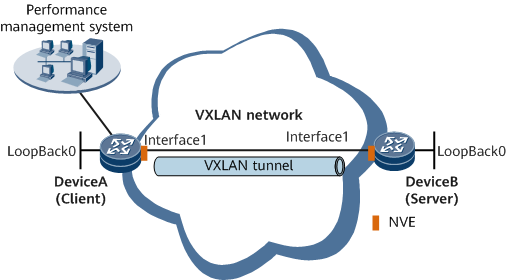Example for Configuring TWAMP on an L3 VXLAN
This section provides an example for configuring TWAMP functions on an L3 VXLAN.
Networking Requirements
On the L3 VXLAN shown in Figure 1, DeviceB functions as the Server (supports only passive measurement) in a TWAMP test. DeviceA functions as the Control-Client. It initiates statistics collection by specifying the IP address of DeviceB. DeviceA then sends collected statistics to the performance management system.

DeviceA must be able to function as the Controller. Data is sent using data collection technology such as telemetry. For details about the configuration procedure, see the corresponding third-party product manual.
Configuration Roadmap
- Configure a VXLAN tunnel between DeviceA and DeviceB.
- Configure the Server on DeviceB.
- Configure the Session-Reflector on DeviceB.
Data Preparation
To complete the configuration, you need the following data:
- IP addresses of interfaces connecting devices
- TCP port number
Procedure
- Assign an IP address to each node interface, including the loopback interface.
For configuration details, see Configuration Files.
- Configure an IGP (IS-IS in this example) on the backbone network.
For configuration details, see Configuration Files.
- Configure a VXLAN tunnel between DeviceA and DeviceB.
For details about the configuration roadmap, see VXLAN Configuration. For configuration details, see Configuration Files.
After a VXLAN tunnel is established, you can run the display vxlan tunnel command on DeviceA to view VXLAN tunnel information.
[~DeviceA] display vxlan tunnel Number of vxlan tunnel : 1 Tunnel ID Source Destination State Type Uptime ----------------------------------------------------------------------------------- 4026531841 1.1.1.1 2.2.2.2 up dynamic 00:12:56
- Set the forwarding mode of the VXLAN tunnel to hardware loopback.
# Configure DeviceA.
[~DeviceA] global-gre forward-mode loopback
# Configure DeviceB.
[~DeviceB] global-gre forward-mode loopback
- Configure the Server.
[*DeviceB] nqa twamp [*DeviceB-twamp] server [*DeviceB-twamp-srv] tcp listen-mode any-ip [*DeviceB-twamp-srv] tcp port 65530 vpn-instance vpn1 [*DeviceB-twamp-srv] quit
- Configure the Session-Reflector.
[*DeviceB-twamp] reflector [*DeviceB-twamp-ref] quit [*DeviceB-twamp] quit [*DeviceB] commit
- Verify the configuration.
# View global TWAMP information on DeviceB.
[~DeviceB] display twamp global-info Start Time : 2019-08-05 16:47:55 Control Session Numbers : 10 Control Session Rejected Numbers : 0 Test Session Numbers : 10 Test Session Completed Numbers : 10 Test Session Aborted Numbers : 0 Test Tx Numbers : 100 Test Rx Numbers : 100
# View TWAMP control session information on DeviceB.
[~DeviceB] display twamp control-session verbose State : active Control Session ID : 0 Client IP : 192.168.1.1 Client Port : 65530 Server IP : 192.168.2.2 Server Port : 65530 VPN Instance : - Mode : unauthenticated Inactivity Time(s) : - Test Session Number : 10 Created Time : 2019-08-05 16:47:55 Normal Stop : 100 Abort Stop : 10
# View TWAMP test session information on DeviceB.
[~DeviceB] display twamp test-session verbose State : active Sender IP : 192.168.1.1 Sender Port : 65530 Reflector IP : 192.168.2.2 Reflector Port : 65530 Session ID : 192.168.2.1:1039033631:FCF9C6DA Control Session ID : 1 Mode : unauthenticated DSCP : 03 Padding Length : 128 VPN Instance : vpn1 Create Time : 2019-08-05 16:47:55 Last Start Time : 2019-08-05 16:47:55 Last Stop Time : never Sequence Number : 2000 Test Tx Numbers : 100 Test Rx Numbers : 100 Test Discard Numbers : 0
Configuration Files
-
# sysname DeviceA # evpn vpn-instance evrf3 bd-mode route-distinguisher 10:1 apply-label per-instance vpn-target 11:1 export-extcommunity vpn-target 11:1 import-extcommunity # ip vpn-instance vpn1 ipv4-family route-distinguisher 11:11 apply-label per-instance vpn-target 1:1 export-extcommunity vpn-target 11:1 export-extcommunity evpn vpn-target 1:1 import-extcommunity vpn-target 11:1 import-extcommunity evpn vxlan vni 5010 # bridge-domain 10 vxlan vni 10 split-horizon-mode evpn binding vpn-instance evrf3 # isis 1 network-entity 10.0000.0000.0001.00 # interface Vbdif10 ip binding vpn-instance vpn1 ip address 10.1.1.1 255.255.255.0 arp distribute-gateway enable arp collect host enable # interface GigabitEthernet0/1/0 undo shutdown ip address 192.168.1.1 255.255.255.0 isis enable 1 # interface LoopBack0 ip address 1.1.1.1 255.255.255.255 isis enable 1 # interface Nve1 source 1.1.1.1 vni 10 head-end peer-list protocol bgp # bgp 100 peer 2.2.2.2 as-number 100 peer 2.2.2.2 connect-interface LoopBack0 # ipv4-family unicast undo synchronization peer 2.2.2.2 enable # l2vpn-family evpn undo policy vpn-target peer 2.2.2.2 enable peer 2.2.2.2 advertise irb peer 2.2.2.2 advertise encap-type vxlan # global-gre forward-mode loopback # return
-
# sysname DeviceB # evpn vpn-instance evrf3 bd-mode route-distinguisher 20:1 apply-label per-instance vpn-target 11:1 export-extcommunity vpn-target 11:1 import-extcommunity # ip vpn-instance vpn1 ipv4-family route-distinguisher 22:22 apply-label per-instance vpn-target 2:2 export-extcommunity vpn-target 11:1 export-extcommunity evpn vpn-target 2:2 import-extcommunity vpn-target 11:1 import-extcommunity evpn vxlan vni 5010 # bridge-domain 20 vxlan vni 20 split-horizon-mode evpn binding vpn-instance evrf3 # isis 1 network-entity 10.0000.0000.0002.00 # interface Vbdif20 ip binding vpn-instance vpn1 ip address 10.2.1.1 255.255.255.0 arp distribute-gateway enable arp collect host enable # interface GigabitEthernet0/1/0 undo shutdown ip address 192.168.2.2 255.255.255.0 isis enable 1 # interface LoopBack0 ip address 2.2.2.2 255.255.255.255 isis enable 1 # interface Nve1 source 2.2.2.2 vni 20 head-end peer-list protocol bgp # bgp 100 peer 1.1.1.1 as-number 100 peer 1.1.1.1 connect-interface LoopBack0 # ipv4-family unicast undo synchronization peer 1.1.1.1 enable # l2vpn-family evpn undo policy vpn-target peer 1.1.1.1 enable peer 1.1.1.1 advertise irb peer 1.1.1.1 advertise encap-type vxlan # nqa twamp server tcp listen-mode any-ip tcp port 65530 vpn-instance vpn1 reflector # global-gre forward-mode loopback # return
